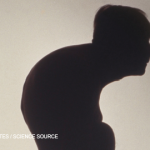
Ankylosing spondylitis commonly affects the joints between the spinal bones and the sacroiliac joints.
Dominique Duval/Science Source
The initial diagnosis of ankylosing spondylitis did not come quickly or easily; indeed, as a young adult, Mr. Hitch, had experienced several years of back pain that frequently necessitated use of non-steroidal anti-inflammatory medications, with only mild relief of his symptoms. More than one doctor suggested these symptoms were due to “growing pains,” and he was also told that he may have fibromyalgia. It was his dogged determination—the same willpower that allowed him to succeed in the military despite the significant physical symptoms he was experiencing—that prompted him to continue to search for answers regarding the etiology of his back pain. When he was eventually found to be HLA-B27 positive and to have evidence of sacroiliitis with erosive disease on imaging, it became clear which organic process was contributing to his functional limitations.
Mr. Hitch notes that he has been asked the BASFI questions multiple times in the past, mostly when working with physical therapists in the treatment of his ankylosing spondylitis [see Figure 1 below]. He explains that certain questions are quite helpful in getting at the heart of the daily activities that are affected by symptoms of ankylosing spondylitis, such as putting on socks, bending forward from the waist to pick up objects on the ground, and reaching up to place an item on a high shelf. Other questions are not included in the BASFI that many patients with ankylosing spondylitis would clearly relate to, such as questions about limitations in bathing (i.e., getting in and out of a tub, washing one’s body in the shower and needing to adapt one’s hygiene routine based on limitations posed by symptoms).
Mr. Hitch also notes that many patients with ankylosing spondylitis would likely understand the conundrum posed by physical activity, for example. He explains that physical activity in moderation often helps his symptoms, but that too much activity or performing the same activity for too long will exacerbate his pain. Thus, he indicates that it would be helpful if patient-reported outcomes included a time parameter and measured how long a patient can perform an activity before being limited by pain or other symptoms.
Increasing Public Awareness
In addition to one’s own experience with a disease, Mr. Hitch points out that hearing from other patients can be helpful and bring attention to conditions that would otherwise be neglected in typical conversations in the lay press or at work. For example, he cites Mick Mars, the guitarist for the rock band Mötley Crüe, as a celebrity who has spoken quite publicly and repeatedly about his diagnosis of ankylosing spondylitis and what it means to persevere in a demanding music career despite the symptoms that he experiences.
Mr. Hitch explains that with increasing public awareness of ankylosing spondylitis, fewer cases of this diagnosis will be missed, and individuals who have patiently treated their back, neck or hip pain conservatively can be further evaluated by a rheumatologist. Indeed, recognizing that HLA-B27 is inherited in a Mendelian fashion and recalling that his father has experienced back pain for many years, Mr. Hitch urged his father to seek evaluation, leading to a correct diagnosis of ankylosing spondylitis, just like his son.

